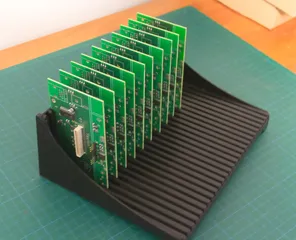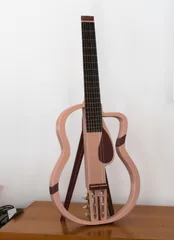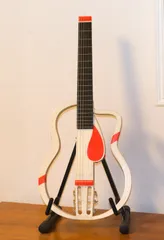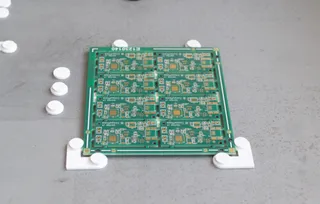Mini-tray for SMD components, version 2B
Description
PDFThe mini-tray was designed as an alternative to the standard JEDEC tray for semiconductors. It has the same width as a JEDEC tray, but its length is a third of that of a JEDEC tray. Thus, three mini-trays lined up have the same width/length dimensions as one JEDEC tray (the mini-tray is 0.85 mm thinner than a JEDEC tray).
The design of the mini-tray aims at small-scale production and storage of small series of components. Small pick-&-place have limited space for trays, sometimes only a single one. With mini-trays, you have a smaller number of components per tray, but three times as many feeder positions for trays.
The mini-tray design includes a lid (or “cover”). With JEDEC trays, it is common to use another (empty) tray to cover up a tray. Apart from thickness (a lid is thinner than a tray used as a lid), an advantage of a dedicated lid is, that it does not obscure the tab of the tray: this tab is where you will put a label with the part label or description.
The mini-tray is also designed to have a magnet in each of the four corners, so that the lid snaps on the tray (and the mini-trays snap together). There is thus less risk that the components can “wiggle” out of their pockets while you are handling a tray (with its lid on). For storage, it is still recommended to also add a rubber band around a mini-tray with lid. The relatively small size and the more common width/height ratio of the mini-tray makes it fit well in standard 127 mm × 152 mm anti-static sealed bags, together with a small bag with silica gel. These bags are available with grip-lock closing, and so they are reusable.
Like the JEDEC trays, mini-trays have a chamfered corner to indicate orientation. The step sizes (from pocket to pocket) in the horizontal and vertical direction are also copied from JEDEC trays (with some exceptions). The body size in the table excludes the pins (for component packages that have pins); this notation is copied from JEDEC as well.
| Type | Body size | Thickness | Columns | Rows | X-step | Y-step |
|---|---|---|---|---|---|---|
| BGA | 4.5×4.5 | 0.4 ~ 1.0 | 16 | 12 | 7.90 | 7.90 |
| QFP | 5×5 | 0.5 ~ 1.7 | 12 | 9 | 10.50 | 10.10 |
| QFP | 7×7 | 0.5 ~ 1.7 | 10 | 8 | 12.60 | 12.20 |
| QFP | 10×10 | 0.5 ~ 1.7 | 8 | 6 | 15.70 | 15.20 |
| QFP | 12×12 | 0.5 ~ 1.7 | 7 | 5 | 18.00 | 17.90 |
| QFP | 14×14 | 0.5 ~ 1.7 | 6 | 4 | 21.00 | 20.30 |
| QFP | 14×20 | 0.5 ~ 1.7 | 6 | 4 | 21.00 | 24.40 |
| QFP | 20×20 | 0.5 ~ 1.7 | 5 | 4 | 25.40 | 24.40 |
| QFP | 24×24 | 0.5 ~ 1.7 | 4 | 3 | 31.50 | 30.40 |
| QFP | 28×28 | 0.5 ~ 1.7 | 4 | 3 | 32.20 | 32.20 |
| QFP | 32×32 | 0.5 ~ 1.7 | 3 | 2 | 41.48 | 37.82 |
| QFP | 40×40 | 0.5 ~ 1.7 | 2 | 2 | 77.46 | 46.00 |
| QFN/BGA | 3×3 | 0.4 ~ 1.0 | 14 | 11 | 9.20 | 8.80 |
| QFN/BGA | 4×4 | 0.4 ~ 1.0 | 14 | 11 | 9.20 | 8.80 |
| QFN/BGA | 5×5 | 0.4 ~ 1.2 | 14 | 11 | 9.20 | 8.80 |
| QFN/BGA | 6×6 | 0.5 ~ 1.4 | 14 | 11 | 9.20 | 8.80 |
| QFN/BGA | 7×7 | 0.5 ~ 1.4 | 10 | 8 | 12.80 | 11.80 |
| QFN/BGA | 8×8 | 0.5 ~ 1.4 | 10 | 8 | 12.80 | 11.80 |
| QFN/BGA | 9×9 | 0.5 ~ 1.4 | 10 | 8 | 12.80 | 11.80 |
| QFN/BGA | 10×10 | 0.5 ~ 1.4 | 8 | 6 | 16.00 | 14.65 |
| sTSOP-I | 11.8×8 | 0.8 ~ 1.5 | 13 | 5 | 9.85 | 19.0 |
| sTSOP-I | 18×8 | 0.8 ~ 1.5 | 13 | 4 | 9.85 | 24.0 |
| SOIC16W | 7.5×10.3 | 1.4 ~ 2.7 | 10 | 7 | 12.60 | 12.20 |
| SOIC20 | 7.5×12.8 | 1.4 ~ 2.7 | 10 | 6 | 12.60 | 15.20 |
| SOT223 | 3.3×6.6 | 0.8 ~ 1.8 | 12.9 | 9 | 12.60 | 12.20 |
Files
Among the downloads is a set of ready-to-print files for various packages. The OpenSCAD source is split over 3 files (Printables.com automatically unpacked the zip file I put those in). The files are: mini-tray.scad, shapes.scad and mini-tray.json. An added twist is that Printables.com does not like the JSON file either, so I renamed it to mini-tray_json.txt. After downloading, you will have to translate it back.
The JSON file contains settings for various packages (conforming to the table above). Strictly speaking, you do not need it.
Design & Printing Recommendations
For design details, please see https://www.compuphase.com/electronics/minitray.htm.
The design of the mini-tray is in OpenSCAD. Via the OpenSCAD “Customizer”, you can select to print either the mini-tray, the matching lid, or both. The OpenSCAD source file has quite a few options. There are pre-configured settings for common packages, but you can also make a mini-tray for a custom packages.
It is recommended to take some measures for ESD protection. Using ESD-safe PLA is the best, but expensive. (These plastics may also be called anti-static, dissipative or conductive.) In the alternative, apply an ESD-safe coating to the tray (after printing it in standard PLA).
There are four holes in the corners of the mini-tray. These holes are specified in the design as 2.1 mm diameter. Due to the nature of 3D printing, they will typically come out a little smaller; the holes are intended for magnets of ⌀2×5 mm (⌀2×2 mm magnets in the lid).
The text on the tab is “embossed”, but in a sunken frame. The font is configurable in the OpenSCAD source, but we recommend the Geert font, which is optimized for 3D printing. For added contrast, we often mark a filament (colour) switch on the layer below where the text starts, and another filament switch on the layer immediately after it. This way, the sunken frame in which the embossed text is in, has a different colour than the text (and the rest of the tray).
Changes from Version 2
The changes between versions 2B and 2 are subtle. Version 2B is a minor improvement.
The pin style of the components is now taken into account. If a component has gull-wing pins, the tray gets a thin rim in the pockets, which help centre the components.
The choice between embossed text and engraved text on the tab is gone. The original trade-off was: the quality of embossed text was usually better, but it does not allow you to put a label on top of it (since the surface isn't flat). Engraved text allows you to stick a label over the engraved text, but the text has lower quality.
In the new version, text is always embossed, but the embossed text is in a recessed frame. The top of the embossed text is flat with the top of the tab surface.
Changes from Version 1
The original design, version 1, is a stackable mini-tray, to copy the stackable property of standard JEDEC trays. However, for a mini-tray, that property is rather useless. In relation to 3D printing, the drawback of making the mini-tray stackable is that you will either need to print the tray in two parts (which are then glued together), or print with supports (which you will then have to remove after printing).
The OpenSCAD source file still has an option to create a stackable mini-tray, but the ready-to-print 3MF files are all for non-stacking trays.
The previous release for the mini-tray used a relatively fine honeycomb grid for the lid (and for the bottom of the trays). The idea was to make the lid universal: a single lid design to cover every tray, regardless of whatever component the tray holds. I abandoned this because the fine grid made it hard to check on the number of components in the tray with the lid still on. In addition, a tray and its lid are a pair: in practice, we would never print a tray without lid. The important bit is that a tray has a lid, and whether that is a dedicate lid or a universal one, doesn't matter much. The drawback of the universal lid outweighed its advantage.
Finally, the tab is now aligned to the bottom, instead of to the top as in the previous release. This is mainly for ease of printing. More importantly, it is now 3 mm thick, 1 mm thicker than before. (If you set the “stackable” option to true, the tab will be aligned to the top, as it was previously.)
Tags
Model origin
The author remixed this model.





